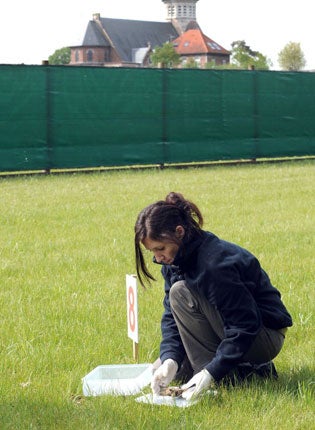First World War mass grave to be excavated

Your support helps us to tell the story
From reproductive rights to climate change to Big Tech, The Independent is on the ground when the story is developing. Whether it's investigating the financials of Elon Musk's pro-Trump PAC or producing our latest documentary, 'The A Word', which shines a light on the American women fighting for reproductive rights, we know how important it is to parse out the facts from the messaging.
At such a critical moment in US history, we need reporters on the ground. Your donation allows us to keep sending journalists to speak to both sides of the story.
The Independent is trusted by Americans across the entire political spectrum. And unlike many other quality news outlets, we choose not to lock Americans out of our reporting and analysis with paywalls. We believe quality journalism should be available to everyone, paid for by those who can afford it.
Your support makes all the difference.Archaeologists will today begin to excavate, and possibly identify, the remains of 400 Australian and British soldiers who were buried in one of the largest mass graves ever found on the battlefields of the First World War.
Over the next four months, the Australian and British governments hope to use DNA evidence to identify at least some of the remains buried in eight large pits near Fromelles in northern France. The bodies are believed to be those of mostly Australian, and some British, soldiers killed in a calamitous attack on German lines on 19 July 1916, which has gone down as one of the most futile and bloody actions of the war.
More than 1,700 Australians – recently arrived from the Gallipoli campaign – were killed during the three-day battle. More than 3,800 were wounded or reported missing in action. Fromelles is estimated to be the worst single calamity in Australian military history. There were also 1,500 British casualties, including 500 deaths.
It is believed that the bodies were collected by the Germans and dumped in the pits, which was common practice with the remains of enemy soldiers. The burial site was identified last year by Glasgow University archaeologists after investigations by two amateur historians from Australia.
The two men complained to the Australian press yesterday that they were being unfairly kept away from the heavily-protected site. Lambis Englezos, a school teacher from Victoria and Tim Whitford, a retired Australian tank commander, have been told that they cannot attend the excavations for longer than 24 hours: "It leaves a really bitter taste," Mr Whitford said.
Individual burials will be given next year to all the bodies in a new Commonwealth War Graves' Commission cemetery. Any bodies identified will be buried under named headstones. The remainder will be given the inscription "A soldier of the Great War".
The Australian army has compiled a list of 190 names of soldiers it believes may lie in the pits in Fromelles. More than 120 relatives have offered DNA samples for cross-checking. The British will run similar checks.
"It's quite a detective story," said Roger Lee, the historian for the Australian army. "We've never found sets of remains on this scale before... We find sites of remains all the time, individuals – five in Belgium was a big number – but this time we could have up to 400."
The battle of Fromelles was ordered as a diversion from the much larger battle of the Somme.
Join our commenting forum
Join thought-provoking conversations, follow other Independent readers and see their replies
Comments